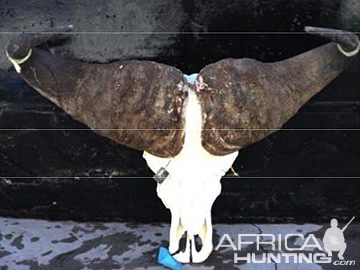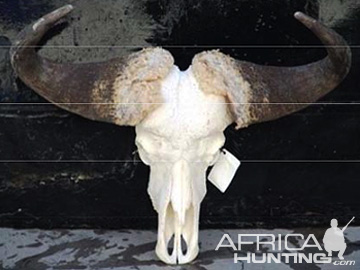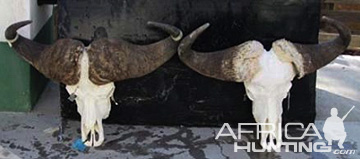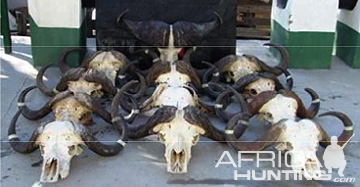- Joined
- Aug 21, 2009
- Messages
- 402
- Reaction score
- 162
- Website
- www.africanindaba.co.za
- Media
- 70
- Articles
- 182
- Member of
- CIC, Rowland Ward, B&C, DSC, German Hunting Association, KZN Hunting Association, Wild Sheep Foundation
- Hunted
- Western US, Western Canada, Alaska, Colombia, Tajikistan, Russian Federation, China, Iran, Austria, Germany, Spain, Czech Republic, UK, Indonesia, South Africa, Zambia, Zimbabwe, Congo, Tanzania, Uganda, Botswana, Namibia
Trophy Scoring and The African Buffalo
by Gerhard R Damm
Regular readers of African Indaba may remember the articles of Kevin Robertson and Winston Taylor in last year’s number 3 issue of African Indaba. Craig Boddington also discussed measuring systems favoring the shooting of pre-prime bulls and disturbing herd structure with a selection of highly experienced African professional hunters in his now well-distributed DVD “Boddington on Buffalo 2”. Tanzanian PH Rainer Josch took up the topic in his recent DVD “Mountain Buffalo” (see review in this issue). Rowland Ward’s initiative regarding a revision of the scoring system for African Buffalo got the attention of buffalo hunters everywhere and many positive comments and suggestions have been received.
The question certainly is not “who has the better scoring system” but rather “how can we modify the present scoring methods so that the buffalo herds in Africa maintain a healthy population structure, allowing us and future generations of hunters to sustainably harvest mature trophy buffalo bulls”. As a second objective we need to create scientifically meaningful statistical evidence concerning this harvest.

1. Mature bull with solid boss
(Spread 36 inches; Boss 14 inches ‐ observe the relatively narrow boss gap)
In order to achieve the objective Rowland Ward works closely together with the CIC International Council for Game and Wildlife Conservation and a number of highly qualified scientists in the field. The general consensus so far points towards harvesting bulls which have passed their prime and are not “needed” as breeding bulls in the herds anymore, respectively have been ejected from the herd. These bulls – usually over ten years of age – have not only passed on their genes, but are also harder to hunt. Moreover the trophy of such a bull sports usually a fully hardened boss with only a small gap between the horn bases. The CIC, Rowland Ward and many other international hunting associations consider that giving more weight to a well developed boss will encourage hunters to hunt older bulls. I don’t want to omit, however, that average boss width varies considerably in regional phenotypes and hunters should also assess the gap between the left and right boss.
I was rather astonished to read in SCI’s Safari Times about a “comparison of the SCI method with one of its competitors” [sic] and furthermore that an evaluation of the trophies in the SCI record book has shown that the trophy quality resp. boss measurements did not show any significant variation over the past decades. It is more than peculiar that one tries to prove the correctness of a scoring system by simply creating average statistical values from within this very system. That you shouldn’t do this is one of the first lessons students hear when they read Statistics.
Kevin Robertson commented recently again the current high ranking bulls in the SCI book – (in particular nos 1, 3, 10 and 17). None of these bulls had a hard boss – so he pointedly asked “I am not too sure how you measure something which is not there”. Robertson and a good number of other buffalo experts suggest that none of these bulls is older than 7 years, and they have been killed long before having had a chance to breed.

2. After boiling and cleaning the skull of a young bull; cartilage dissolved and the boss gap is several inches wide
(Spread 36 inches; Boss 13 + inches)

3. Self-explaining - on the left the bull of photo 1, on the right the youngster of photo 2

4. Mature bulls with hard boss and narrow gap and others who would have needed a few more years to be real trophies
Once on the wall, these younger bulls make of course magnificent displays – since the soft boss, which virtually dis- solves during the boiling process, can be masterfully reconstructed to resemble a fully hardened one. Maybe some hunters have the trophies scored once they are reconstructed? I once again repeat that we need to reconsider the scoring methods for the African Buffalo – Rowland Ward has taken the initiative a year ago and the process, albeit not finished, has created the much needed awareness and public debate. This at least is one positive outcome and I am sure that at the end of this debate we will have a scoring method which does justice to the population dynamics of the African Buffalo.
South African taxidermist Rodney Kretzschmar sent me a series of photographs which underline Robertson’s point – I have reproduced four here with Rodney’s kind permission.
The trophy scoring issue is, however, not limited to the African Buffalo – this was the clear outcome of the workshops and meetings during the General Assembly of the CIC in Marrakech end of April. Since I have been appointed as coordinator of the CIC Commission Exhibitions and Trophies at that meeting, I will tackle the task with this vision in mind:
An innovative approach to trophy hunting, trophy evaluation and trophy monitoring will concentrate on scientifically viable trophy measurements focusing on methods which provide on one hand comprehensive and species-specific biological data and on the other hand the means to intelli- gently use and interpret these data to serve regionally and globally as key wildlife management tool, as indicator of sustainable trophy hunting practices and as a bridge for cooperation with the IUCN Sustainable Use Specialist and Species Specialist Groups.
I said in my presentation in Marrakech that existing systems should not be changed for the sake of change, but also highlighted that every system needs to adapt to changing circumstances in order to remain relevant. Changes need to be based on one side on significant new knowledge about game, game populations, game genetics, zoogeography and the sociobiological importance of horns and antlers in terms of geometry, morphology etc, and on the other side on changing societal perceptions of hunting. Much of today’s knowledge as well as scientific statistical evaluation methods based on state-of-the-art information technology were not available 30 or 40 years ago.
Many researchers have highlighted the influence that selective hunting may have on the population dynamics of game and non-game species. Yet it is common knowledge that data sourced from hunts are inherently biased. Hunters typically select a non-random subset of a game population usually based on anthropocentric perceptions nurtured by trophy scoring methods, thus making hunting the contrary of a random process. There is another constraint inherent with the trophies in the existing record books – in many cases only a relatively small percentage of the trophies taken are scored resp. are eventually entered. This may have consequences for the correct interpretation of hunting and trophy data. We therefore also need to adopt corrective measures for bias introduced in this way, and we need to encourage all hunters to have all their trophies scored.
Change within an existing scoring method does not mean that comparability with past trophy data will disappear. Intelligent database design will assist in safeguarding continuity. It also does not mean that we will have to use complicated formulas in field assessment – a mature trophy will always catch your eye; don’t worry about points and ranking whilst hunting – savor the moment, enjoy the hunt, and go for these old bulls!
by Gerhard R Damm
Regular readers of African Indaba may remember the articles of Kevin Robertson and Winston Taylor in last year’s number 3 issue of African Indaba. Craig Boddington also discussed measuring systems favoring the shooting of pre-prime bulls and disturbing herd structure with a selection of highly experienced African professional hunters in his now well-distributed DVD “Boddington on Buffalo 2”. Tanzanian PH Rainer Josch took up the topic in his recent DVD “Mountain Buffalo” (see review in this issue). Rowland Ward’s initiative regarding a revision of the scoring system for African Buffalo got the attention of buffalo hunters everywhere and many positive comments and suggestions have been received.
The question certainly is not “who has the better scoring system” but rather “how can we modify the present scoring methods so that the buffalo herds in Africa maintain a healthy population structure, allowing us and future generations of hunters to sustainably harvest mature trophy buffalo bulls”. As a second objective we need to create scientifically meaningful statistical evidence concerning this harvest.

1. Mature bull with solid boss
(Spread 36 inches; Boss 14 inches ‐ observe the relatively narrow boss gap)
In order to achieve the objective Rowland Ward works closely together with the CIC International Council for Game and Wildlife Conservation and a number of highly qualified scientists in the field. The general consensus so far points towards harvesting bulls which have passed their prime and are not “needed” as breeding bulls in the herds anymore, respectively have been ejected from the herd. These bulls – usually over ten years of age – have not only passed on their genes, but are also harder to hunt. Moreover the trophy of such a bull sports usually a fully hardened boss with only a small gap between the horn bases. The CIC, Rowland Ward and many other international hunting associations consider that giving more weight to a well developed boss will encourage hunters to hunt older bulls. I don’t want to omit, however, that average boss width varies considerably in regional phenotypes and hunters should also assess the gap between the left and right boss.
I was rather astonished to read in SCI’s Safari Times about a “comparison of the SCI method with one of its competitors” [sic] and furthermore that an evaluation of the trophies in the SCI record book has shown that the trophy quality resp. boss measurements did not show any significant variation over the past decades. It is more than peculiar that one tries to prove the correctness of a scoring system by simply creating average statistical values from within this very system. That you shouldn’t do this is one of the first lessons students hear when they read Statistics.
Kevin Robertson commented recently again the current high ranking bulls in the SCI book – (in particular nos 1, 3, 10 and 17). None of these bulls had a hard boss – so he pointedly asked “I am not too sure how you measure something which is not there”. Robertson and a good number of other buffalo experts suggest that none of these bulls is older than 7 years, and they have been killed long before having had a chance to breed.

2. After boiling and cleaning the skull of a young bull; cartilage dissolved and the boss gap is several inches wide
(Spread 36 inches; Boss 13 + inches)

3. Self-explaining - on the left the bull of photo 1, on the right the youngster of photo 2

4. Mature bulls with hard boss and narrow gap and others who would have needed a few more years to be real trophies
Once on the wall, these younger bulls make of course magnificent displays – since the soft boss, which virtually dis- solves during the boiling process, can be masterfully reconstructed to resemble a fully hardened one. Maybe some hunters have the trophies scored once they are reconstructed? I once again repeat that we need to reconsider the scoring methods for the African Buffalo – Rowland Ward has taken the initiative a year ago and the process, albeit not finished, has created the much needed awareness and public debate. This at least is one positive outcome and I am sure that at the end of this debate we will have a scoring method which does justice to the population dynamics of the African Buffalo.
South African taxidermist Rodney Kretzschmar sent me a series of photographs which underline Robertson’s point – I have reproduced four here with Rodney’s kind permission.
The trophy scoring issue is, however, not limited to the African Buffalo – this was the clear outcome of the workshops and meetings during the General Assembly of the CIC in Marrakech end of April. Since I have been appointed as coordinator of the CIC Commission Exhibitions and Trophies at that meeting, I will tackle the task with this vision in mind:
An innovative approach to trophy hunting, trophy evaluation and trophy monitoring will concentrate on scientifically viable trophy measurements focusing on methods which provide on one hand comprehensive and species-specific biological data and on the other hand the means to intelli- gently use and interpret these data to serve regionally and globally as key wildlife management tool, as indicator of sustainable trophy hunting practices and as a bridge for cooperation with the IUCN Sustainable Use Specialist and Species Specialist Groups.
I said in my presentation in Marrakech that existing systems should not be changed for the sake of change, but also highlighted that every system needs to adapt to changing circumstances in order to remain relevant. Changes need to be based on one side on significant new knowledge about game, game populations, game genetics, zoogeography and the sociobiological importance of horns and antlers in terms of geometry, morphology etc, and on the other side on changing societal perceptions of hunting. Much of today’s knowledge as well as scientific statistical evaluation methods based on state-of-the-art information technology were not available 30 or 40 years ago.
Many researchers have highlighted the influence that selective hunting may have on the population dynamics of game and non-game species. Yet it is common knowledge that data sourced from hunts are inherently biased. Hunters typically select a non-random subset of a game population usually based on anthropocentric perceptions nurtured by trophy scoring methods, thus making hunting the contrary of a random process. There is another constraint inherent with the trophies in the existing record books – in many cases only a relatively small percentage of the trophies taken are scored resp. are eventually entered. This may have consequences for the correct interpretation of hunting and trophy data. We therefore also need to adopt corrective measures for bias introduced in this way, and we need to encourage all hunters to have all their trophies scored.
Change within an existing scoring method does not mean that comparability with past trophy data will disappear. Intelligent database design will assist in safeguarding continuity. It also does not mean that we will have to use complicated formulas in field assessment – a mature trophy will always catch your eye; don’t worry about points and ranking whilst hunting – savor the moment, enjoy the hunt, and go for these old bulls!
Last edited by a moderator: